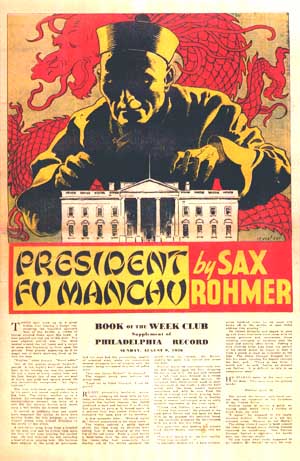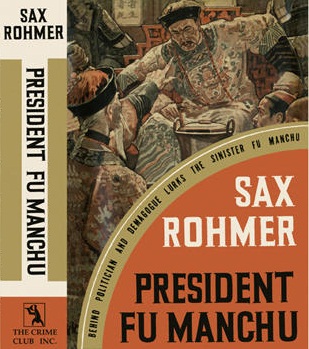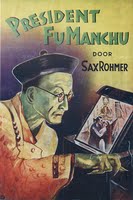Blogging Sax Rohmer’s President Fu Manchu, Part One

 Sax Rohmer’s The Invisible President was originally serialized in Collier’s from February 29 to May 16, 1936. It was published in book form later that year by Cassell in the UK and Doubleday in the US under the title President Fu Manchu. The novel is the first in the series to fictionalize real events with characters based on familiar figures in the US in the 1930s such as Huey Long and Father Charles Coughlin. More than one critic has noted that the story may have influenced the classic Cold War conspiracy thriller The Manchurian Candidate.
Sax Rohmer’s The Invisible President was originally serialized in Collier’s from February 29 to May 16, 1936. It was published in book form later that year by Cassell in the UK and Doubleday in the US under the title President Fu Manchu. The novel is the first in the series to fictionalize real events with characters based on familiar figures in the US in the 1930s such as Huey Long and Father Charles Coughlin. More than one critic has noted that the story may have influenced the classic Cold War conspiracy thriller The Manchurian Candidate.
The novel gets underway with Sir Denis Nayland Smith on special assignment with the FBI in a reworking of the Parson Dan episode from the very first Fu Manchu novel over twenty years before. Rohmer is much more comfortable with his second effort at a third person narrative for the series.
The early chapters do an admirable job of introducing Smith and his opposite number, FBI Agent Mark Hepburn, into the life of the highly controversial radio talk show host, Abbot Patrick Donegal. The celebrated Catholic priest had his manuscript on the foreign power threatening the USA stolen from his studio at the Tower of the Holy Thorn during his most recent broadcast. Abbot Donegal can recall nothing of the theft or even the contents of the manuscript he prepared.
Smith deduces from Father Donegal’s planner that the information came from his recent private interview with presidential candidate Dr. Orwin Prescott at his farm in Connecticut. Immediate suspicion falls on Fr. Donegal’s Eurasian secretary, James Richet. Smith believes Dr. Prescott has learned that his rival Harvey Bragg’s campaign is backed by the Si-Fan. Fr. Donegal agrees with Smith that if the progressive Bragg is elected president, the US will fall to a dictatorship. Amazingly, right wing conspiracy theories over sinister forces behind a social justice candidate are very much relevant again 80 years later, lending the book a very modern edge to it.

 Hepburn encounters one of Fr. Donegal’s staff, Mrs. Adair, slipping out of James Richet’s room after dark. He detains the attractive young woman and discovers she is taking home papers to work on for Fr. Donegal overnight. He arranges for a driver to escort her home and takes the papers from her. Mrs. Adair gives the driver the slip and flees in the night.
Hepburn encounters one of Fr. Donegal’s staff, Mrs. Adair, slipping out of James Richet’s room after dark. He detains the attractive young woman and discovers she is taking home papers to work on for Fr. Donegal overnight. He arranges for a driver to escort her home and takes the papers from her. Mrs. Adair gives the driver the slip and flees in the night.
The recovered papers are Fr. Donegal’s missing manuscript and confirm Orwin Prescott was aware the Si-Fan are backing Harvey Bragg, as Smith surmised. Warrants for the arrest of the now missing James Richet and Mrs. Adair are issued. Smith and Hepburn rush by train to reach Dr. Prescott’s farm in Connecticut. They soon learn Prescott has been abducted. Dr. Fu Manchu phones Smith at Prescott’s house and warns him to choose his next move carefully, as Dr. Prescott and Fr. Donegal’s lives depend upon his actions.
Hepburn proves himself an able chemist who is able to identify a South American drug called kaapi that wiped Fr. Donegal’s memory of his interview with Dr. Prescott. Nayland Smith notes that Fu Manchu had recently used this drug during an unrecorded adventure in South America. Smith disguises himself as a member of the Salvation Army to comb New York’s Chinatown district. There he spies James Richet, but loses him. However, he is pleased that his sighting confirms Fu Manchu is operating from a base in Chinatown.
Several brief scenes with Fu Manchu in his Chinatown base are surprisingly ineffective and unnecessary. They read as if they would better suit the Fu Manchu radio series of the era than they do a novel, where they seem intrusive and add no suspense. The strength of the character’s limited appearances in previous books was for the protagonist’s awe of encountering this towering foreign intellect. Devoid of such interaction robs the character of his mystery. Rohmer briefly informs the reader that James Richet is smitten with a Si-Fan operative known as Lola Dumas, but without an introductory scene for her character, this development appears clumsy and under-developed.
Smith and Hepburn believe they are close to making an arrest when James Richet’s corpse turns up in the back of a taxi. His body is covered in strange scarlet spots. The book is largely well-written, but the disjointed interludes with Fu Manchu throw off the balance. It appears to have needed at least one more draft to smooth out some of the rougher sections. A true pity since this paranoid political thriller is surprisingly sharp and biting.
William Patrick Maynard was authorized to continue Sax Rohmer’s Fu Manchu thrillers beginning with The Terror of Fu Manchu (2009; Black Coat Press) and The Destiny of Fu Manchu (2012; Black Coat Press). Next up is a collection of short stories featuring an original Edwardian detective, The Occult Case Book of Shankar Hardwicke, The Triumph of Fu Manchu, and a hardboiled detective novel, Lawhead. To see additional articles by William, visit his blog at SetiSays.blogspot.com